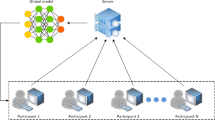Abstract
In Internet of Things (IoT), data sharing among different devices can improve manufacture efficiency and reduce workload, and yet make the network systems be more vulnerable to various intrusion attacks. There has been realistic demand to develop an efficient intrusion detection algorithm for connected devices. Most of existing intrusion detection methods are trained in a centralized manner and are incapable to identify new unlabeled attack types. In this paper, a distributed federated intrusion detection method is proposed, utilizing the information contained in the labeled data as the prior knowledge to discover new unlabeled attack types. Besides, the blockchain technique is introduced in the federated learning process for the consensus of the entire framework. Experimental results are provided to show that our approach can identify the malicious entities, while outperforming the existing methods in discovering new intrusion attack types.
Similar content being viewed by others
References
Li X, Hu Z, Xu M, Wang Y, Ma J. Transfer learning based intrusion detection scheme for internet of vehicles. Information Sciences, 2021, 547: 119–135
Razian M, Fathian M, Wu H, Akbari A, Buyya R. SAIoT: scalable anomaly-aware services composition in CloudloT environments. IEEE Internet of Things Journal, 2021, 8(5): 3665–3677
Deng S, Zhao H, Fang W, Yin J, Dustdar S, Zomaya Y A. Edge intelligence: the confluence of edge computing and artificial intelligence. IEEE Internet of Things Journal, 2020, 7(8): 7457–7469
Jiang D, Song Y, Tong Y, Wu Y, Zhao W, Xu Q, Yang Q. Federated topic modeling. In: Proceedings of the 28th ACM International Conference on Information and Knowledge Management. 2019, 1071–1080
Mothukuri V, Khare P, Parizi M R, Pouriyeh S, Dehghantanha A, Srivastava G. Federated-learning-based anomaly detection for IoT security attacks. IEEE Internet of Things Journal, 2022, 9(4): 2545–2554
Song T, Tong Y, Wei S. Profit allocation for federated learning. In: Proceedings of 2019 IEEE International Conference on Big Data. 2019, 2577–2586
Wu Q, Chen X, Zhou Z, Zhang J. FedHome: cloud-edge based personalized federated learning for in-Home health monitoring. IEEE Transactions on Mobile Computing, 2022, 21(8): 2818–2832
Alkadi O, Moustafa N, Turnbull B, Choo K K R. A deep blockchain framework-enabled collaborative intrusion detection for protecting IOT and cloud networks. IEEE Internet of Things Journal, 2021, 8(12): 9463–9472
Tong Y, Pan X, Zeng Y, Shi Y, Xue C, Zhou Z, Zhang X, Chen L, Xu K, Lv W. Hu-Fu: efficient and secure spatial queries over data federation. Proceedings of the VLDB Endowment, 2022, 15(6): 1159–1172
Abdel-Basset M, Moustafa N, Hawash H, Razzak I, Sallam K M, Elkomy O M. Federated intrusion detection in blockchain-based smart transportation systems. IEEE Transactions on Intelligent Transportation Systems, 2022, 23(3): 2523–2537
Chen H, Asif A S, Park J, Shen C C, Bennis M. Robust blockchained federated Learning with model validation and proof-of-stake inspired consensus. In: Proceedings of AAAI 2021 Workshop - Towards Robust, Secure and Efficient Machine Learning. 2021
Ashraf J, Bakhshi D A, Moustafa N, Khurshid H, Javed A, Beheshti A. Novel deep learning-enabled LSTM autoencoder architecture for discovering anomalous events from intelligent transportation systems. IEEE Transactions on Intelligent Transportation Systems, 2021, 22(7): 4507–4518
Shi Y, Tong Y, Su Z, Jiang D, Zhou Z, Zhang W. Federated topic discovery: a semantic consistent approach. IEEE Intelligent Systems, 2021, 36(5): 96–103
Wu Y, Dai N H, Wang H. Convergence of blockchain and edge computing for secure and scalable IIoT critical infrastructures in industry 4. 0. IEEE Internet of Things Journal, 2021, 8(4): 2300–2317
Liu H, Zhang S, Zhang P, Zhou X, Shao X, Pu G, Zhang Y. Blockchain and federated learning for collaborative intrusion detection in vehicular edge computing. IEEE Transactions on Vehicular Technology, 2021, 70(6): 6073–6084
D’Angelo G, Castiglione A, Palmieri F. A cluster-based multidimensional approach for detecting attacks on connected vehicles. IEEE Internet of Things Journal, 2021, 8(16): 12518–12527
Yang J, Chen X, Chen S, Jiang X, Tan X. Conditional variational autoencoder and extreme value theory aided two-stage learning approach for intelligent fine-grained known/unknown intrusion detection. IEEE Transactions on Information Forensics and Security, 2021, 16: 3538–3553
Nie L, Wu Y, Wang X, Guo L, Wang G, Gao X, Li S. Intrusion detection for secure social internet of things based on collaborative edge computing: a generative adversarial network-based approach. IEEE Transactions on Computational Social Systems, 2022, 9(1): 134–145
Lin T E, Xu H, Zhang H. Discovering new intents via constrained deep adaptive clustering with cluster refinement. In: Proceedings of the 34th AAAI Conference on Artificial Intelligence. 2020, 8360–8367
Han K, Rebuffi S A, Ehrhardt S, Vedaldi A, Zisserman A. Automatically discovering and learning new visual categories with ranking statistics. In: Proceedings of the 8th International Conference on Learning Representations. 2020
Castro M, Liskov B. Practical byzantine fault tolerance. In: Proceedings of the 3rd Symposium on Operating Systems Design and Implementation. 1999
Rezvy S, Luo Y, Petridis M, Lasebae A, Zebin T. An efficient deep learning model for intrusion classification and prediction in 5G and IoT networks. In: Proceedings of the 53rd Conference on Information Sciences and Systems. 2019, 1–6
Dennis D K, Li T, Smith V. Heterogeneity for the win: one-shot federated clustering. In: Proceedings of the 38th International Conference on Machine Learning. 2021
Kolias C, Kambourakis G, Stavrou A, Gritzalis S. Intrusion detection in 802.11 networks: empirical evaluation of threats and a public dataset. IEEE Communications Surveys & Tutorials, 2016, 18(1): 184–208
Han S, Pool J, Tran J, Dally W J. Learning both weights and connections for efficient neural networks. In: Proceedings of the 28th International Conference on Neural Information Processing Systems. 2015
Zhang G, Pan F, Dang’ana M, Mao Y, Motepalli S, Zhang S, Jacobsen H A. Reaching consensus in the Byzantine Empire: a comprehensive review of BFT consensus algorithms. 2022, arXiv preprint arXiv: 2204.03181
Alshammari M, Stavrakakis J, Takatsuka M. Refining a k-nearest neighbor graph for a computationally efficient spectral clustering. Pattern Recognition, 2021, 114: 107869
Barkhordar E, Shirali-Shahreza H M, Sadeghi R H. Clustering of Bank Customers using LSTM-based encoder-decoder and Dynamic Time Warping. 2021, arXiv preprint arXiv: 2110.11769
Guo W, Lin K, Ye W. Deep embedded K-means clustering. In: Proceedings of 2021 International Conference on Data Mining Workshops. 2021
Li H, Ye X, Imakura A, Sakurai T. Ensemble learning for spectral clustering. In: Proceedings of 2020 IEEE International Conference on Data Mining. 2020, 1094–1099
Xie B, Dong X, Wang C. An improved K-means clustering intrusion detection algorithm for wireless networks based on federated learning. Wireless Communications and Mobile Computing, 2021, 2021: 9322368
Acknowledgements
This work was supported in part by the National Key R&D Program of China (2018AAA0101100), and in part by the National Natural Science Foundation of China (Grant Nos. 62022008 and 92067204).
Author information
Authors and Affiliations
Corresponding author
Ethics declarations
Competing interests The authors declare that they have no competing interests or financial conflicts to disclose.
Additional information
Nan Sun received BS degree in Detection Guidance and Control from Northwestern Polytechnical University, China in 2018 and MS degree in Aeronautical and Astronautical Science and Technology from Harbin Institute of Technology, China in 2020, respectively. He is currently pursuing the PhD degree with the School of Cyber Science and Technology, Beihang University, China. His research interests include attack detection and federated learning.
Wei Wang received her BEng degree in Electrical Engineering and Automation from Beihang University, China in 2005, MSc degree in Radio Frequency Communication Systems with Distinction from University of Southampton, UK in 2006 and PhD degree from Nanyang Technological University, Singapore in 2011. From January 2012 to June 2015, she was a lecturer with the Department of Automation at Tsinghua University, China. Currently, she is an associate professor with the School of Automation Science and Electrical Engineering at Beihang University and supported by BUAA Young Talent Recruitment Program. Her research interests include adaptive control of uncertain systems, distributed cooperative control of multi-agent systems, fault tolerant control, secure control of cyber-physical systems, and flight control systems.
Yongxin Tong received the PhD degree in Computer Science and Engineering from The University of Hong Kong of Science and Technology, China in 2014. He is currently a professor in the School of Computer Science and Engineering, Beihang University, China. His research interests include federated learning, privacy preserving data analytics, big spatio-temporal data analytics, crowdsourcing and reinforcement learning. He published more than 100 papers in prestigious international journals (e.g., ACM TODS, IEEE TKDE, and VLDBJ) and conferences (e.g., SIGMOD, SIGKDD, VLDB, and ICDE). He is an associate editor for IEEE Transactions on Knowledge and Data Engineering (TKDE), etc. He received Alibaba DAMO Academy Young Fellow in 2018, the Excellent Demonstration Award from VLDB 2014, the champion from KDD Cup 2020.
Kexin Liu received the MSc degree in Control Science and Engineering from Shandong University, China in 2013, and PhD degree in System Theory from Academy of Mathematics and Systems Science, Chinese Academy of Sciences, China in 2016, respectively. From 2016 to 2018, he was a postdoctoral fellow in Peking University, China. Currently, he is an associate professor with the School of Automation Science and Electrical Engineering, Beihang University, China. His research interests include multi-agent systems and complex networks.
Electronic supplementary material
Rights and permissions
About this article
Cite this article
Sun, N., Wang, W., Tong, Y. et al. Blockchain based federated learning for intrusion detection for Internet of Things. Front. Comput. Sci. 18, 185328 (2024). https://doi.org/10.1007/s11704-023-3026-8
Received:
Accepted:
Published:
DOI: https://doi.org/10.1007/s11704-023-3026-8




